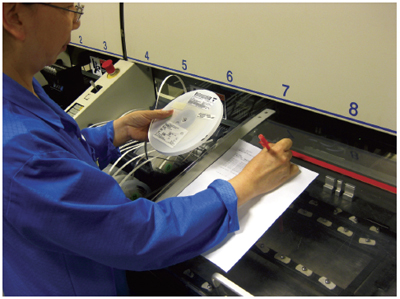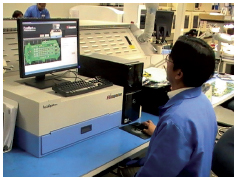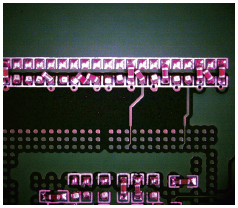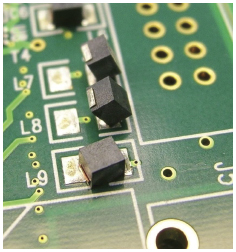Ensuring Accurate Placement
Component assembly is ripe for defects. Here’s how to avoid them.
Placement must undergo various checks to ensure components are the correct ones and to locate potential problems. The first check is at the SMT stage (Figure 1). Called a feeder component check, it involves identifying each part on the reels or trays and matching them with the bill of materials. Quality Control checks item number, component size and values, and ensures that what’s called out in the BoM is what’s on the specific reel or tray.

Figure 1. QC technician conducting a feeder component check to verify each part is identified on the tape and reel and matched with the BoM.
After these checks are satisfactorily completed, QC signs off on the manufacturing process instructions (MPI) form. SMT can then run the first-article board so it can go through screen-printing and pick-and-place. When the board goes through pick-and-place, the machine checks components once again. To perform those checks, pick-and-place equipment uses the dimensions of each part by size and the number of leads on the part. The machine also verifies the thickness of each part. Other checks like coplanarity can be performed to check for bent leads on fine-pitch devices.
(Note that different pick-and-place equipment has different options. Not all machines can handle the wide range of component sizes. Sometimes a custom feeder must be ordered to be able to accurately perform placement. Some feeders are difficult to find for a few odd-shaped devices, especially connectors. For the most part, a third-party is called on to make a special feeder for a particular component.)
QC then re-checks that first-article board after it has undergone a placement from the pick-and-place machine, but prior to reflow. Ideally, a first-article inspection (FAI) system is used (Figure 2). This system, programmed to perform a particular inspection on a particular board, checks component markings and, again, matches components with the already programmed golden board. FAI is a major contributor toward eliminating backend rework.

Figure 2. FAI is used after first board undergoes pick-and-place, but before going to reflow to perform another round of checking.
So-called “consigned components” are parts cut from the tape-and-reel and provided to production in an exact number. This is not a good idea: For optimum accuracy, automated assembly needs components in a tape-and-reel. Components from a cut tape must be hand placed and can lead to higher rates of misalignment, bridging or opens.
Further, because there are no markings on these cut tapes at the placement, the wrong components for a job might get mixed in. Having FAI prior to reflow is especially valuable in these instances. As mentioned, floor personnel can check components prior to board reflow to make sure all components are the right ones per the BoM.
Problems also are encountered when components with different values are mixed and placed on trays and bins. Most often, these are salvaged from dead boards and have bent or oxidized leads that could lead to open or insufficient solder after reflow. Avoid salvaged or “pulled” components; they pose reliability issues.
Matching Pad and Package Sizes
Pad designs at the layout stage often present challenges for placement. Sometimes pad designs don’t match the component package sizes specified in the BoM (Figure 3). Consequently, problems arise at placement because the parts are either too big or too small for the pad, resulting in component mismatch. Assembly is halted on that project to report this discrepancy to the customer: The reply usually is to replace it with a different-size component or a notice to not populate that particular component. 
Figure 3. Pad design doesn’t match with component called out in the BoM.
There are countless examples where this discrepancy can occur. Take, for instance, an 0603 part called out in the BoM for a PCB with an 0402 pad design. Assembly issues are encountered when this particular part is placed. An open solder condition is going to result because the 0603 part won’t be able to be placed on that smaller 0402 pad.
Similarly, if an 0402 part needs to go in an 0603 pad design, tombstoning will occur. When a particular side of the part is pulled through on one side, the component stands up (Figure 4) or tombstones. Moreover, there will be open solder and misalignment after this part goes through reflow.
Figure 4. Tombstoning occurs when incorrect pad sizes are used on a PCB.
A BGA pad design with pads of different sizes is the exception rather than the rule at most EMS firms. But occasionally, due either to poor design or fabrication practices, some boards come with different BGA pad sizes. Such situations call for consulting with the customer.
Ideally, BGA pads should be uniformly sized as far as overall PCB pad design is concerned. Assembly personnel do not want to face a mix of small and big BGA pads on the PCB. Such design can lead to open solder conditions and subsequently, latent product problems in the field. Hence, the BGA pad design must be identical to the BGA ball configuration, which is uniform throughout the device.
Unmasking via holes is another associated problem. This creates insufficient solder, especially on a BGA component as it goes through reflow. Here, solder is sucked through the unmasked via hole, thereby creating insufficient or open problems with the BGA. This issue is compounded because conventional x-ray doesn’t spot it, although the equipment clearly sees bridging. (Advanced x-ray machines do see open solder, as well as bridging.)
For successful, accurate placement, PCB designers must interact with assembly and process engineers to ensure the right components are used. They should define and coordinate the various requirements of assembly. In particular, at SMT, PCB designers and assembly engineers must coordinate and place onto the PCB a global fiducial. A GF is used for alignment purposes at screen-printing and pick-and-place. It’s basically a starting point for aligning the solder paste on the board pad. The printer will look for the global fiducial so that it can center boards and apply solder paste cleanly and accurately. A GF is equally important on the pick-and-place machine, specifically for fine-pitch components and leadless devices like BGAs. A local fiducial will help with placement alignment consistency throughout the board, particularly with fine-pitch parts and leadless devices. Assembly and design engineers must coordinate with all these requirements to ensure accurate placement.
Careful design and assembly coordination also involves exchanging detailed information dealing with pad designs. Assembly should provide the design team with a list of components and their matching pad designs. This means matching 0402 parts with an 0402 pad design, an 0603 with a corresponding 0603 pad design, and so on.
Finally, close coordination is essential when dealing with special type or odd-shaped components or connectors. Design and production groups work in tandem to specify and order ahead of time the type of nozzle or equipment needed. Anticipating this need and having special equipment ready considerably helps maintain an OEM’s project schedule, regardless whether it is a prototype or production assembly.
Simon Ilustre is a process engineer at NexLogic Technologies (www.nexlogic.com); info@nexlogic.com.
Press Releases
- Altus Reports Growing Demand for Guidance on Convection Reflow Oven Specification
- Coherix Opens New Adhesive-Dispensing Vision Center in Europe
- Pan Pacific Strategic Electronics Symposium Program Finalized
- The Most Critical 2 Inches in SMT Manufacturing – When a Splice Fails, the Line Fails, Full Stop. Throughput and Yield Depend on One Overlooked Moment







